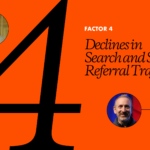The era of mobile-first has truly arrived. In the United States, 79% of all digital minutes are now spent on mobile devices, according to Comscore. A big chunk of that time goes on digital content, with 82% of views of news and information now coming from mobile.
Publishers are seeing the same trend, with State of Digital Publishing reporting that 70-80% of views now come from mobile devices. Small surprise, then, that many publishers are retooling their digital platforms to be mobile-first, to meet their readers’ changing consumption habits.
But is there more in it for publishers than just maintaining the status quo? A growing body of evidence says that mobile-first publishing doesn’t just help to retain existing audiences. It also creates more opportunities to engage audiences in conversation — in turn increasing their loyalty and generating more revenue.
Apps can outstrip mobile web for audience engagement
The biggest question around mobile audience engagement has always been around whether it’s better to go down the responsive website route or invest in a mobile app. And while responsive websites are now a no-brainer for publishers, given that the majority of views come from mobile, there are also extremely good arguments for offering a separate app:
App users are always logged in: Readers are automatically logged in when they access the app, rather than having to manually log in when they go to the website. More logged-in readers means more opportunity to personalize content to the individual user, which is proven to increase the amount of time spent reading and the number of articles read.
Apps boost paid subscriptions: If a reader goes to the effort of installing an app, it means they’re already fans of the content, which makes it easier to convert them to a paid subscription. French newspaper Le Parisien told WAN-IFRA in 2020 that more than 50% of their subscriber conversions now come from the newspaper’s app.
They also drive retention: App users become engaged fans who want to stick around. The Washington Post told AdWeek in March 2021 that subscribers who use its app to consume content stay subscribed for longer and tend to read more articles.
And they’re a great source of first-party data: Logged-in app users are a rich source of data about what readers are specifically interested in, particularly if they go on to leave comments. As we head towards a cookieless future, first-party data from known users will be essential to publishers’ ad revenue strategies.
Enabling quality in-app conversations with OpenWeb’s mobile SDKs
Mobile apps are great for increasing engagement, subscriptions, loyalty, and ad revenue, but there’s even more to it than that.
One of the biggest drivers of audience engagement is the ability not just to consume but also to interact — with the content itself, with other readers, and with editorial teams. In fact, we’ve found that users who are active in the comments section spend up to 3.6x more time on-site than non-engaged users.
That means a sophisticated third-party commenting system, like OpenWebOS, can be a force multiplier of the value that mobile apps already deliver. Here are just a few of the ways publishers can use OpenWebOS to attract, manage, retain and grow the value of a mobile app audience:
Enable conversations on any app platform: Our mobile software development kit (SDKs) let publishers implement our Conversations module in Android, iOS or React-native apps, to create a fully-functional and customizable commenting system for app users. Now, app users can get involved in the conversation just as easily as desktop and mobile web users.
Keep conversation civil with multi-layered moderation: Encourage high-quality conversations that users will want to read, engage with, participate in and come back to. Our powerful hybrid of AI-powered and human moderation identifies and filters out toxic comments so the conversation remains both civil and brand-safe.
Enable personalized ads: Maximize the monetization capabilities of the app’s comments section, using first-party data to personalize ads to users in the Conversations module. OpenWeb mobile SDKs allow for both banner and interstitial ads, creating powerful opportunities for brands to be seen by the right people at the right time.
Maximize audience engagement on mobile with OpenWeb
There’s no going back to the desktop: mobile is now overwhelmingly the way audiences want to consume content. And for publishers, that’s a good thing — particularly given the higher levels of engagement and retention enabled by mobile apps.
Savvy publishers can capitalize on that by making the mobile app a place for quality conversation: one where readers can not only get the content they want, but also enrich it with their own views, and enjoy the company of a community of like-minded people. For publishers, that’s a recipe for loyal, long-term readers — and improved revenues. Find out more about enabling quality in-app conversations with OpenWeb SDKs.


